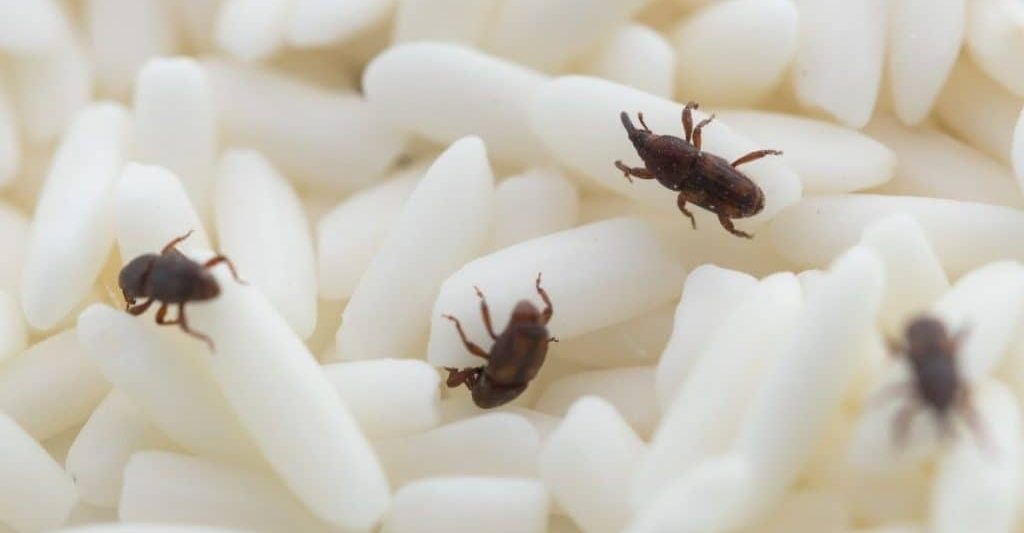
There may be insects where there is food (hey, pests like to eat, just as we do). Pantry moths, weevils, and tiny beetles are the most prevalent pests in pantries. They may bother you, but they are not very harmful since they won’t harm your house or bite or sting you.
But, my kitchen is tidy
Pests often come along with your food items at the grocery store, during delivery, or even way back at the processing plant or warehouse. This means that even in the cleanest kitchen, pests can make a home for themselves.
To combat this, pantry shelves can be cleaned with warm water and white vinegar. Additionally, you can use bay leaves as a natural detergent.
- Add bay leaves directly to canisters and packages of dry goods, such as flour, rice, and other grains. Their pungent scent effectively repels many pantry pests, keeping your food safe.
- One bay leaf per container should do the trick, providing a simple yet effective barrier against unwanted visitors.
By incorporating bay leaves, you may avoid future infestations, serving as a home remedy rather than relying on pest control services.
What food products are they drawn to?
The majority of pantry pests like snacking on grains, including flours, cereals, dried goods, and processed foods, as well as dried fruits, beans, nuts, and spices, however, they are not particular about what they eat. Almost any dry food kept at room temperature has the potential to attract common pantry pests. Unsealed containers that have been opened provide excellent targets since they make entrance simple, although many insects can also enter sealed packaging.
Flour beetles are notorious for infesting a variety of pantry staples. These pests are commonly found in grains, such as flour and rice. They also target dried fruits, spices, and other seasonings. Additionally, nuts and beans are not safe from their reach. Their presence in stored food items begins with them being mistaken for small ants. Be vigilant with your pantry to keep them at bay.
Get the vacuum cleaner out once you have completely cleaned out your pantry of all food. Your pantry’s floor and shelves should be cleaned up. Ensure that you reach every corner. It’s time to wipe out each shelf in your pantry as well as the surrounding floor once you’ve vacuumed the area.
Instead of using harsh chemicals, use soapy water or a natural all-purpose cleaner for this. Powerful pesticides might be harmful to your family if they come into touch with food, but they won’t do much to lower the risk of bugs returning.

The Impact of Indian Meal Moths on Stored Food
Indian meal moths are notorious for targeting pantry items, making them a common nuisance in households. They are attracted to an array of dried and processed foods, including dried fruits, grains, seeds, nuts, chocolate, candies, bird seed, dog food, powdered milk, and dried red peppers.
Physical Characteristics
These moths typically measure about 5/8 to 3/4 inches in length. You may notice them fluttering near ceiling lights, a behavior characteristic of many moth species.
Contamination Concerns
One of the major concerns with Indian meal moths is their ability to compromise food safety. They lay eggs in food products, leading to larval infestation. The larvae are the primary culprits behind food damage. As they develop, they produce a silken web material, which can be found both in the corners of pantry shelves and within food packaging.
Signs of Infestation
Discovering web-like material inside food packages is a clear indicator of contamination. This webbing not only signals the presence of pests but also deems the food unsafe for consumption. Once infested, any such food should be discarded to prevent potential health hazards.
By understanding these impacts, you can take proactive steps to protect your pantry and maintain the integrity of your stored foods.
How Regular Inspection of Dried Food Products Helps in Pest Prevention
Regularly inspecting dried food items is a proactive step in maintaining a pest-free kitchen. Here’s how it aids in pest prevention:
- Early Detection: By routinely checking dried foods like grains and cereals, you can quickly spot any initial signs of pests such as larvae or webbing. This early detection allows you to address issues before they become full-blown infestations.
- Quality Assurance: Consistent inspections help ensure the quality and condition of your stored food. Noticing changes in texture, color, or smell can be a telltale sign of possible pest activity, enabling you to take swift action.
- Reducing Habitats: Frequent checks can reveal vulnerabilities in your storage methods. Airtight containers are your best defense, minimizing opportunities for pests to thrive.
- Cost Savings: Spotting problems early prevents the need for extensive pest control measures, saving you time and money in the long run.
Routine inspections are a small investment of time that can reap significant benefits in protecting your pantry from unwanted intruders.
Understanding Weevil Reproduction and Its Impact on Stored Grains
Weevils, those tiny nuisances found in pantries, have a fascinating yet troubling reproductive process. Female weevils begin by boring a tiny hole into a grain kernel, where they lay a single egg and then seal the opening using natural secretions. This secure environment allows the egg to safely hatch inside the grain.
Once hatched, the larva feasts on the grain, gradually making its way out as it develops, eventually emerging as an adult weevil ready to continue the cycle.
Types and Impact
There are several types of weevils, including:
- Rice weevils
- Wheat weevils
- Granary weevils
- Maize weevils
Infestation becomes a significant issue once these pests invade stored foodstuffs such as wheat, oats, rye, barley, rice, and corn. Their presence not only consumes the stored grains, causing a considerable loss, but also contaminates them. The combination of their feeding habits and waste production renders the grain unfit for human consumption, leading to spoilage and potential health risks.
In summary, weevils reproduce by laying eggs inside grains, which disrupts food supplies and leads to economic losses. Controlling these pests is crucial for maintaining the quality of stored grains.
Why Checking Expiration Dates on Baking Ingredients Matters
When you’re preparing to bake your favorite treats, it’s easy to overlook the importance of expiration dates on your ingredients. However, prioritizing this simple step can have a significant impact on both the quality of your food and your health. Here’s why it matters:
Ensure Optimal Taste and Texture
- Preserve Flavor: Ingredients like baking powder and yeast can lose their potency over time. Using expired leavening agents might result in baked goods that are flat and lack rise.
- Maintain Quality: Spices and other flavorings tend to lose their intensity past their expiration dates. Fresh ingredients ensure your baked goods taste as delicious as intended.
Health and Safety Concerns
- Avoid Contamination: Expired ingredients might harbor bacteria or mold, which can cause foodborne illnesses. Certain perishable items, such as dairy, are especially prone to this risk.
- Prevent Allergic Reactions: Ingredients may change chemically as they degrade. Such changes might unpredictably affect people sensitive or allergic to specific compounds.
Financial and Environmental Considerations
- Reduce Food Waste: Regularly checking expiration dates helps you use ingredients before they spoil, minimizing waste and saving money.
- Eco-Friendly Baking: Utilizing fresh ingredients more efficiently contributes to reduced overall waste—benefiting both your wallet and the environment.
By routinely verifying expiration dates on your baking ingredients, you’re ensuring that what you serve is safe, flavorful, and eco-conscious. Taking this precaution can make all the difference in your culinary creations.
Lay down the insect spray
The next step is to apply an essential oil to repel pests. Remove pesticides from your pantry. You don’t want it to go into your meal, obviously. Eight drops of the essential oils Eucalyptus, Peppermint, Lavender, and Clove, along with half a cup of water and half a cup of vinegar, should be added to the mixture to repel insects.
Spray the liquid into a container, or use it to dampen a microfiber cloth. After cleaning the whole pantry, leave it alone for five to ten minutes.
It’s time to put everything back where it belongs when the shelf and floor have dried. It’s crucial to inspect all of your packing once more when you’re doing this. You don’t want to put infected food back on the shelves of the pantry. Otherwise, you’ll simply have to start again with the pantry bug issue.

Make wise food choices to stop pantry bugs from prospering
There are certain items where pantry bugs are more likely to flourish. Pantry bugs like eating as much as we do. Flours, cereals, processed meals, dried fruits, beans, nuts, and spices are a few of their favorite foods. Nonetheless, it should be mentioned that they are not fussy eaters and do well with different meals.
Food must be kept properly in order to reduce the risk of contamination. As most of these meals demonstrate, they are kept at room temperature. That is the ideal temperature for pantry bugs to flourish.
As a result, you must take care to avoid leaving these goods in their unopened packaging around. Use airtight food containers to avoid pantry pests and leaving opened packages.
Effective Precautions for Avoiding Pantry Pests
To ensure your kitchen stays free from unwanted pests, consider implementing these key steps when purchasing food items:
- Inspect Packaging Thoroughly:
Always examine food packaging for any signs of damage before buying. Check boxes of cereals, grains, flour, and other pantry staples for punctures or tears which could serve as entry points for pests. - Opt for Sealed Packages:
Prioritize purchasing products that come in sealed and secure containers. Items in airtight or vacuum-sealed packages are less likely to be compromised by pest infestations. - Evaluate Expiration Dates:
Check expiration or best-before dates to ensure that you are purchasing fresh products. Older items are more prone to attract pests due to prolonged storage. - Avoid Bulk Bins:
While buying in bulk may be tempting, open bins can harbor insects. When possible, choose pre-packaged goods to minimize risk. - Choose Transparent Packaging:
Select products packaged in clear materials, allowing you to visually confirm the product’s integrity and the absence of visible pests.
By incorporating these measures during your grocery shopping trips, you can significantly reduce the likelihood of introducing pantry pests into your home. Happy shopping!
How do you keep pests out of your pantry once you’ve got them under control?
These are some steps you can do to stop pantry bugs from returning if you’ve already had an infestation and want to be sure it doesn’t happen again:
Food should be rotated more often since pantry bugs are more likely to develop the longer food sits in the pantry. Buying food in smaller quantities and rotating your stock more often is one of the simplest methods to keep your pantry free of pests.

Employ airtight containers
Don’t keep your food in its original packaging to reduce the danger of a re-infestation with pantry bugs. You should put rice, wheat, cereal, and even biscuits that you just bought in airtight containers. These containers provide two advantages. They do a terrific job of helping you keep your pantry more organised in addition to keeping pantry pests away.
Increase the frequency with which you clean your kitchen and pantry. You may need to be extra watchful. We don’t intend to be excessive, but you need to watch out that there aren’t any crumbs left around for too long. More often, clean your pantry, and when you make a mistake, clean it up right away.
Please get in contact with us right away if you’d like a free estimate for cleaning your house or some tips on how to get rid of pantry bugs. We’d be delighted to assist you.




